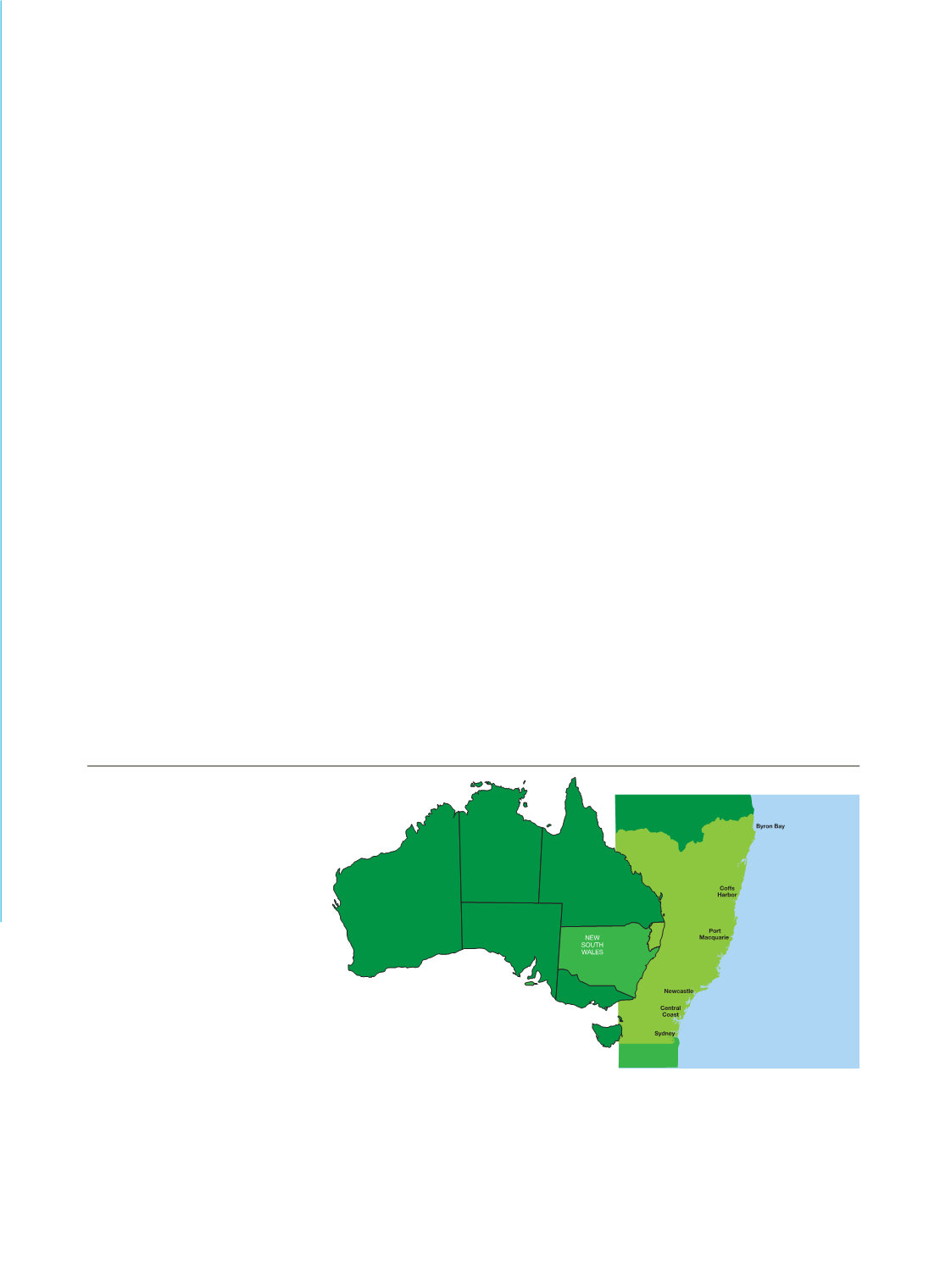
 ALERTDIVER.COM
ALERTDIVER.COM
|
81
HOW TO DIVE IT
GETTING THERE:
Many international airlines
fly into Brisbane and Sydney, and local
connections are available to Coffs Harbor
(adjacent to the Solitary Islands Marine
Park). From Brisbane or Sydney, the drive
to South West Rocks can take six hours.
Many visitors (including U.S. citizens) will
need a short-term visa or an Electronic
Travel Authority (ETA) to visit Australia. Visit
australia.gov.aufor details.
SEASONS, EXPOSURE PROTECTION AND
MARINE LIFE:
Water temperatures fluctuate
greatly with the seasons in this part of New
South Wales, with winter (May-August) low
temperatures dipping to the low 60s°F and
late summer temperatures getting into the
upper 70s°F; a 5 mm wetsuit is adequate in
summer, but a 7 mm wetsuit with a hood is
a better choice during the winter. Because of
the wide differences in water temperatures,
the marine life also varies by season. Divers
who visit during
the winter months are
more likely to interact with gray nurse
sharks as well as giant cuttlefish at all
sites. Summer months may yield manta
ray and zebra shark sightings. Wobbegong
sharks, black cod and many types of rays can
be viewed year-round. The waters around Fish
Rock (which can have cool thermoclines year-
round) are a good place to view gray nurse
sharks regardless of season. (Note: We visited
in March.)
SKILL LEVEL AND CONDITIONS:
Sites in
this area can vary widely in terms of depth,
current and surge, so be sure to inform
the dive operation about your skill level to
ensure your dives are enjoyable. The closest
hyperbaric chambers are in Sydney and
Brisbane.
tank on board has been emptied. The boat heads back
to the mainland, and we watch wistfully as Lion’s Den
disappears on the horizon.
HOW THE ZEBRA GOT HIS SPOTS
Our guide looks sternly at me as we motor,
Perfect-
Storm
-style, through the surf zone. “I’m glad you’re not
gonna debate me on whether they are leopard sharks or
zebra sharks. Everyone here calls them leopard sharks.”
I dismiss an urge to discuss the “other” leopard sharks,
the ones that inhabit the waters off our home state of
California. Fact is, we are here to see (apologies to our
guide) zebra sharks. Aside from the fact that leopard
sharks appear more stereotypically sharklike while zebra
sharks’ faces resemble that of the Pillsbury Doughboy,
it’s easy to see how a misunderstanding could arise:
True leopard sharks are spotted throughout life, and the
stripes that adorn juvenile zebra sharks fade to become
spots as the animals mature. The end result is the same:
spotted sharks that can be reliably seen at certain times
of the year, though in different locations.
We moor near the eastern edge of the rocks and
drop into 30 feet of water, kicking over to
Needles
,
a series of ledges, rocks and sand channels. When
we arrive at what seems to be the epicenter of shark
action, we settle behind a rock, hoping that our gray
nurse shark plan will work equally well here (and
feeling quite thankful that zebra sharks swim at a
comparatively faster pace). Before long, zebra sharks
are swimming overhead at regular intervals. Shortly
thereafter other marine life is also passing us, including
various rays, hunting octopuses and jellyfishes, the
latter occasionally pursued by a hungry turtle. Between
the cartoonish faces of the zebra sharks and the near-
constant trigger-pulling motion of depressing a camera
shutter button, the whole setup has a bit of a video
game vibe: zebra shark, zebra shark, bonus eagle ray,
zebra shark, zebra shark, triple bonus loggerhead. This
is a lazy, entitled shooter’s delight: The zebra sharks
seem to operate on a circuit, so there is little need to
move other than to slightly adjust one’s shooting angle.
As we climb back on board, another boat has called to
tell us about a manta sighted on the other side of the
rocks. We look at one other with amusement, smiling
benevolently. (ONE manta? And we’d have to move?)
The ridiculousness of our reaction is not lost on me.
In just two weeks we have become so utterly spoiled
that the prospect of a single manta is unexceptional,
less than a dozen zombie sharks per dive is thoroughly
inadequate, I forget to appreciate wobbegongs, and I
compare dozens of zebra sharks to a game of Space
Invaders. The Boomerang Coast warrants its name
for several reasons; one is that my return is absolutely
guaranteed. And next time, no matter how much
New South Wales spoils me, I will make it a point to
photograph every wobbegong I see.
AD
















